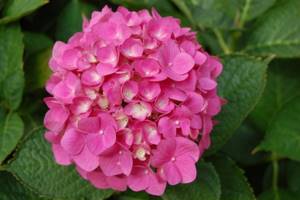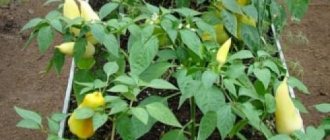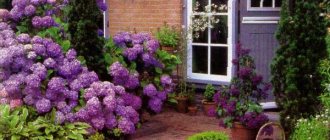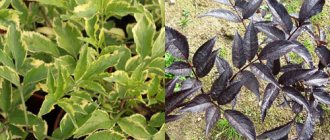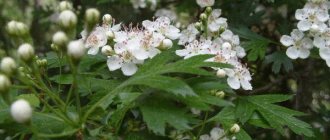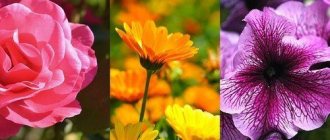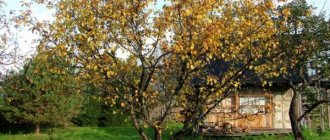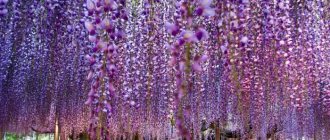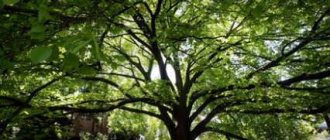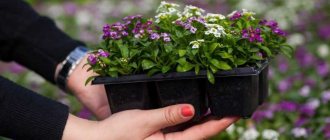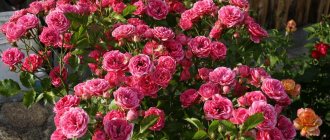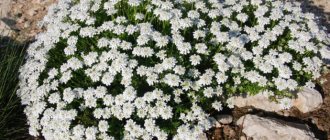Irga Lamarckii (Amelanchier Lamarckii)
Irga Lamarckii (A. Lamarckii) is a large, hardy shrub of the Rosaceae family, which came to Europe from North America. Most often it grows in the form of a bush or multi-stemmed tree with a height of 2 to 6 m, forming a beautiful, umbrella-like crown. The leaves of the serviceberry are small, dense, oval in shape, the fruits look like small apples collected in a cluster.
Although Lamarck's serviceberry is a fruit plant, it is grown mainly for decorative purposes. The shrub looks spectacular during flowering in May and at the end of June, when the purple-violet berries ripen.
The fruits of the serviceberry are sweet and taste like blueberries.
But the real benefit of the plant comes in the fall. It is impossible to count all the shades found in its crown: golden yellow colors turn into orange-salmon and copper-red tones, malachite greens are adjacent to purple highlights. A bright fire blazes in the rays of the autumn sun until the frosts, until the foliage falls, exposing a compact, thin-branched crown on slender stems.
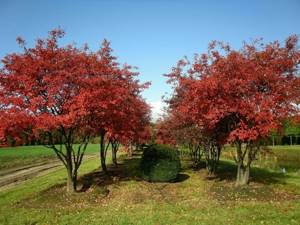
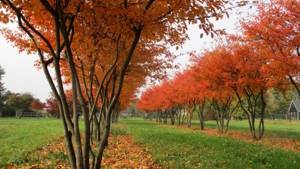
You, darling, look good in all your outfits - irga in the fall
In the garden, irga prefers sunny and semi-shaded places with loose, slightly sandy soil; it will grow well in slightly acidic soils. One of its main advantages is the ability to easily tolerate even severe frosts (down to −30 °C).
Shrubs can be planted in spring and autumn. Before planting, add humus or complex mineral fertilizer to the soil to give the seedling a quick start. Do the same thing every spring, and this will be enough for good growth and abundant fruiting of the crop.
Irga care is minimal. It should only be watered during periods of extreme heat or prolonged drought. Its crown is of the correct shape, so the bush does not need to be trimmed; sanitary cleaning is enough.
In the garden, Lamarck's shadberry is used as a tapeworm or in plant compositions with other trees and shrubs. It can also be grown on a trellis, using it for zoning the garden.
Euonymus alatus Compactus
The winged euonymus (E. alatus) of the compactus variety is not for nothing called the king of the autumn garden. It has such an amazing purple-crimson color that it seems as if the bush is illuminated from the inside.
The plant is a highly branched deciduous shrub with a compact dome-shaped crown. It grows up to 1.5 m in height and up to 2 m in width. Unlike the species form, it grows slowly, which is also a plus, especially for small gardens. The plant blooms in early summer with small, inconspicuous flowers hidden in a dense crown of dense green leaves.
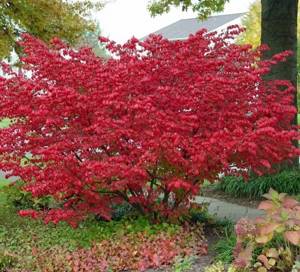
Even if this shrub was unremarkable the rest of the year, it would still be worth planting for its fall foliage alone
The stems of the bush also attract attention. Along each shoot there are sharp cork ribs, giving the branches a tetrahedral shape and an unusual “winged” appearance. Thanks to this, it looks spectacular in winter and early spring, until the foliage blooms.
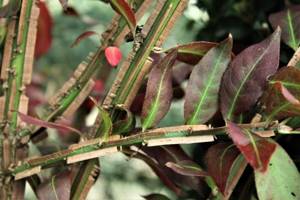
The tetrahedral branches for which the euonymus received the specific name “winged”
The “compactus” variety will perform better in a sunny place with loose, fertile soil. It can grow in the shade, but then the autumn foliage will not be so bright. The plant is planted in spring and autumn. When planting in autumn, mulch the root zone with a layer of compost or peat - this way the bush will overwinter better. The rooted shrub is winter-hardy in the conditions of the Kaliningrad region and does not need shelter.
The weak point of the winged euonymus is the superficial root system, which is sensitive to excessive compaction, drying out and waterlogging of the soil. To prevent this, we recommend mulching the ground around the trunk or making a decorative fill. For good growth, the shrub needs annual spring fertilizing with complete fertilizer.
In the garden, euonymus is planted in the most visible place - on the lawn, in the front garden, at the entrance to the house. It makes excellent trimmed hedges and borders. The bush looks impressive on an alpine hill, giving it a Japanese flavor.
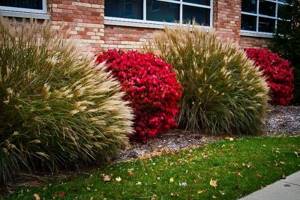
Winged euonymus - a bright decoration of the autumn garden
Please note that B. winged "compactus" has poisonous fruits. So be careful when planting it if you have small children.
Magnolia
Evergreen magnolia is also classified as a rose shrub, although in the wild it can grow as a tree up to 30 m high. In spring it attracts attention with large (up to 15 cm) pink flowers with a rich aroma; in winter it retains its decorative value thanks to its dark purple fruits framed by a green crown . The period of their appearance depends on the variety. Often flowering begins very early, while there are no bees and butterflies yet, but the rich aroma attracts other insects to pollinate the magnolia. For its abundance, it is important to provide a sufficient amount of sunlight and abundant watering.
Not all varieties are suitable for central Russia, since the delicate magnolia buds are very sensitive to frost. For the winter, plants require shelter: the trunk is wrapped in burlap, the root system is insulated with fallen leaves, straw or bark.
Related article:
5 beautiful winter-hardy shrubs that should definitely be in your dacha
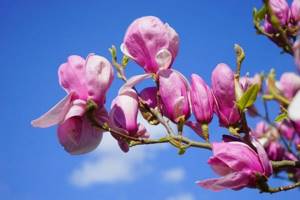
Thunberg's barberry "green carpet" (Berberis Thunbergii Green Carpet)
Because of its flattened, cushion-shaped crown, the Thunberg barberry variety “green carpet” received the name carpet bush (green carpet is translated from English as “green carpet”). Indeed, it rarely rises above 60–80 cm, but in width it can grow up to 1.5 m. Why not a rug?
Like the species shrub, it is decorated with thin arched shoots, literally covered with small graceful foliage. It is decorative throughout the season, but is especially beautiful in the fall, when it turns scarlet red and orange.
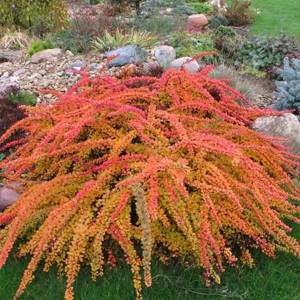
Autumn outfit of Thunberg barberry variety "green carpet"
In November, the leaves fall, but red berries remain on the bush, decorating it throughout the winter.
The Green Carpet variety will grow well in regular garden soil in a sunny or slightly shaded location. It does not need increased nutrition, but if you feed the bush with complete fertilizer in the spring, it will look much better. A strong branched root system increases the plant's resistance to drought and frost.
The plant can be trimmed, but the bushes look more impressive when they grow freely. B. Thunberg's "green carpet" is beautiful in borders, on alpine hills, as a lower tier in compositions with trees and tall shrubs that expose the bottom.
Garden hibiscus (Syrian)
A deciduous tree-like shrub, reaching a height of 2-2.5 m, can be grown in a garden plot without much hassle. But for regions with cold winters, you need to take care of its shelter for the winter. Otherwise, you only need to water the hibiscus when the ground around it becomes dry, periodically apply fertilizers, prevent the growth of weeds in the neighborhood and prune for sanitary purposes and to give the bushes the desired shape.
Related article:
What are the names of shrubs that bloom with white flowers?
Large (up to 12 cm) pink flowers of different shades are formed only on the shoots of the current year. They can have a simple, terry or semi-double structure. The buds bloom and fade within 48 hours. But due to the abundant flowering, which usually lasts from early July until autumn, such a short period of life for each of them is almost invisible.
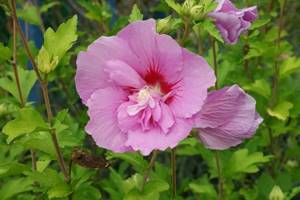
Flowering dogwood (Cornus florida)
Flowering dogwood (C. florida) is a deciduous tree or shrub 4–6 m high with a wide spreading crown on thin slender stems. The plant's homeland is the eastern parts of North America, where it grows on forest edges.
This type of dogwood has two peaks of decorativeness. In early spring, it blooms very beautifully: a cluster of small greenish-yellow flowers is surrounded by four large petals-bracts (bracts) of white or pink hue.
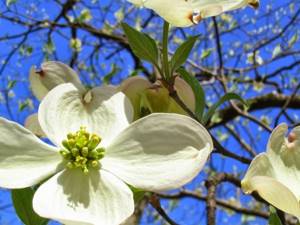
C. florida in bloom is a stunning sight
Flowering turf also looks no less impressive in the fall. Its foliage acquires such a bright crimson color that it seems as if a fire is burning in the garden. In winter, red berries serve as an additional decoration - inedible for people, but very loved by birds.
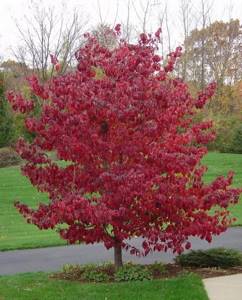
Autumn outfit of blooming dogwood
Although the tree is rare in our gardens, it is not difficult to grow. The plant loves the sun, but not hot sun. A place where it will be well lit in the morning and slightly shaded at noon will suit it. Deren prefers fertile, moisture-permeable soil with an acidic pH reaction. The first year after planting requires regular watering, then water only in case of prolonged drought.
In the Kaliningrad region, the shrub is winter-hardy, but since it has a shallow root system, it is better to mulch the tree trunk of young plants in the winter. The optimal planting time is spring.
During flowering, Florida grass goes well with rhododendrons and azaleas. Formed in the shape of a tree, it looks beautiful near a pond, on the lawn, and will decorate the patio.
Bodinier's beautiful fruit, or Bodinier's beautiful fruit (Callicarpa Bodinieri)
The yellow palette of the garden can be painted not only with crimson, but also with purple colors. This is exactly the impression that Bodinier's beautiful fruit, or Bodinier's callicarpa, makes, thanks to its numerous clusters of berries of a rich purple hue.
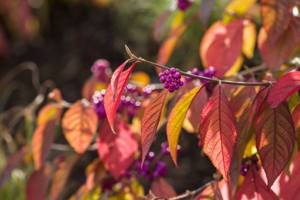
This is what Bodiniere's beautiful fruit looks like in September
The beautiful carp is an erect deciduous shrub from Western China, growing from 1.5 to 3 m in our country. The pubescent shoots are decorated with long, pointed leaves of a dark green color, and from June - small purple flowers.
During the summer it does not attract much interest, so it is usually planted in the background of mixborders. The bush appears in all its glory from mid-September, when the small, pearl-like berries acquire a purple-violet hue. They are collected in clusters of 30–40 pieces and remain on the bush even after the leaves fall, sometimes lasting until mid-winter.
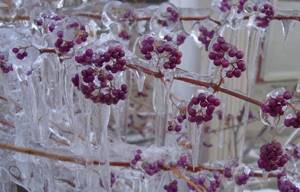
Bodinier's beautiful fruit - a decoration not only for the autumn, but also for the winter garden
In the garden, give the beautiful fruit a sunny, cozy place protected from the wind. The soil needs to be rich in humus, well drained and not too heavy. At a young age, the shoots of the beautiful fruit can freeze slightly, so for the first time after planting it is better to cover it for the winter.
The beautiful fruit is a cross-pollinated crop, so for abundant fruiting in the garden you need to plant at least two plants. The varieties Profusion, Leococarpa, and Lilac Pearl are considered the best for our climate.
Hydrangea
Unpretentious hydrangeas attract attention with lush spherical inflorescences that abundantly strew the bushes. Large multi-colored leaves add decorativeness. Depending on the variety, the height of the plants varies between 1.5-3 m. They grow well in acidic, loose soil, require regular moisture and annual pruning, and do not tolerate scorching sun and drought.
Related article:
Cypress varieties
Lush flowering can be observed with sufficient sunlight. In semi-shaded areas, hydrangea will bloom much later, and the number of flowers will decrease significantly. Drafts can cause serious damage to plants. Tree and paniculate hydrangeas are considered the most frost-resistant. Chinese and Japanese varieties are less resistant to cold and more demanding to care for.
